

Hura crepitans. Hura crepitans, the sandbox tree,[2] also known as possumwood and jabillo, is an evergreen tree of the spurge family (Euphorbiaceae), native to tropical regions of North and South America, including the Amazon Rainforest.

It is recognized by the many dark, pointed spines and smooth brown bark. These spines have caused it to be called Monkey no-climb. Paul K. Van Riper. At the time of his retirement, Van Riper was serving as the Commanding General, Marine Corps Combat Development Command, Quantico, Virginia.

Early life[edit] Paul K. Van Riper was born on July 5, 1938 in Brownsville, Pennsylvania. Marine Corps career[edit] New Mexico whiptail. The hybridization of these species prevents healthy males from forming whereas males do exist in both parent species (see Sexual differentiation).
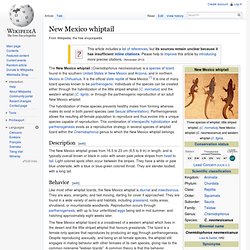
Parthenogenesis allows the resulting all-female population to reproduce and thus evolve into a unique species capable of reproduction. This combination of interspecific hybridization and parthenogenesis exists as a reproductive strategy in several species of whiptail lizard within the Cnemidophorus genus to which the New Mexico whiptail belongs. Mamluk. Mamluk (Arabic: مملوك mamlūk (singular), مماليك mamālīk (plural), meaning "property" or "owned slave" of the king; also transliterated as mamlouk, mamluq, mamluke, mameluk, mameluke, mamaluke or marmeluke) is an Arabic designation for slaves.

An Egyptian Mamluk warrior in full armor and armed with lance, shield, sabre and pistols. More specifically, it refers to: While mamluks were purchased, their status was above ordinary slaves, who were not allowed to carry weapons or perform certain tasks. In places such as Egypt from the Ayyubid dynasty to the time of Muhammad Ali of Egypt, mamluks were considered to be “true lords", with social status above freeborn Muslims.[10] Overview[edit] The origins of the Mamluk system are disputed. The use of mamluk soldiers gave rulers troops who had no link to any established power structure. Phineas Gage. Phineas P.
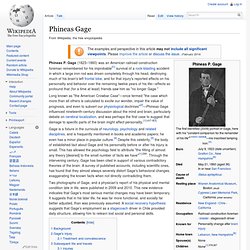
Gage (1823–1860) was an American railroad construction foreman remembered for his improbable[C] survival of a rock-blasting accident in which a large iron rod was driven completely through his head, destroying much of his brain's left frontal lobe, and for that injury's reported effects on his personality and behavior over the remaining twelve years of his life—effects so profound that (for a time at least) friends saw him as "no longer Gage.
" Long known as "the American Crowbar Case"—once termed "the case which more than all others is calculated to excite our wonder, impair the value of prognosis, and even to subvert our physiological doctrines"[2]—Phineas Gage influenced nineteenth-century discussion about the mind and brain, particularly debate on cerebral localization, and was perhaps the first case to suggest that damage to specific parts of the brain might affect personality.[1]:ch7-9[3] Background[edit] Gage's injury[edit] Harlow took charge of the case around 6 p.m. Elohim. Maimonides. Mosheh ben Maimon (משה בן מימון), called Moses Maimonides (/maɪˈmɒnɪdiːz/ my-MON-i-deez) and also known as Mūsā ibn Maymūn (Arabic: موسى بن ميمون), or RaMBaM (רמב"ם – Hebrew acronym for "Rabbeinu Mosheh Ben Maimon" – English translation: "Our Rabbi/Teacher Moses Son [of] Maimon"), was a preeminent medieval Arab, Spanish, Sephardic Jewish philosopher, astronomer[5] and one of the most prolific and influential Torah scholars and physicians[6][7][8] of the Middle Ages.
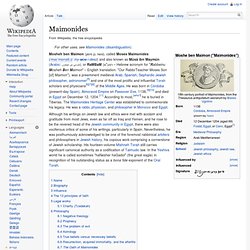
He was born in Córdoba (present-day Spain), Almoravid Empire on Passover Eve, 1138,[9][10] and died in Egypt on December 12, 1204.[11] According to most,[who?] Carl Panzram. Carl Panzram (June 28, 1891 – September 5, 1930) was an American serial killer, rapist, arsonist and burglar.
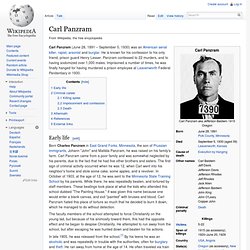
He is known for his confession to his only friend, prison guard Henry Lesser. Panzram confessed to 22 murders, and to having sodomized over 1,000 males. Imprisoned a number of times, he was finally hanged for having murdered a prison employee at Leavenworth Federal Penitentiary in 1930. Early life[edit] The Game (mind game) The Game is a mental game where the objective is to avoid thinking about The Game itself.
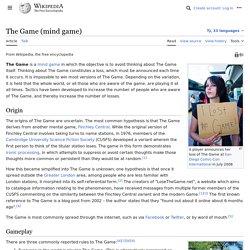
Thinking about The Game constitutes a loss, which, according to the rules of The Game, must be announced each time it occurs. It is impossible to win most versions of The Game; players can only attempt to avoid losing for as long as they possibly can. Coolidge effect. In biology and psychology, the Coolidge effect is a phenomenon seen in mammalian species whereby males (and to a lesser extent females) exhibit renewed sexual interest if introduced to new receptive sexual partners,[1][2][3][4] even after refusing sex from prior but still available sexual partners.
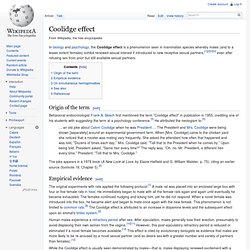
Origin of the term[edit] Behavioral endocrinologist Frank A. Much Ado About Nothing. Facsimile of the title page of the quarto version of Much adoe about Nothing Much Ado About Nothing is a comedic play by William Shakespeare thought to have been written in 1598 and 1599, as Shakespeare was approaching the middle of his career.
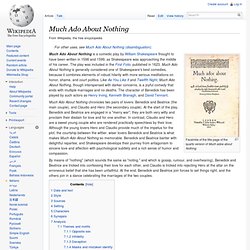
The play was included in the First Folio, published in 1623. Much Ado About Nothing is generally considered one of Shakespeare's best comedies, because it combines elements of robust hilarity with more serious meditations on honor, shame, and court politics. Like As You Like It and Twelfth Night, Much Ado About Nothing, though interspersed with darker concerns, is a joyful comedy that ends with multiple marriages and no deaths. Micromort. A micromort is a unit of risk measuring a one-in-a-million probability of death (from micro- and mortality). Micromorts can be used to measure riskiness of various day-to-day activities.
A microprobability is a one-in-a million chance of some event; thus a micromort is the microprobability of death. The micromort concept was introduced by Ronald A. Howard who pioneered the modern practice of decision analysis.[1] Human values[edit] History of the Jews in Egypt. Egyptian Jews constitute both one of the oldest and youngest Jewish communities in the world. [clarification needed] In the late 1950s Egypt expelled its Jewish population and sequestered Jewish-owned property. Prahlad Jani. Prahlad Jani, also known as "Mataji", (born Chunriwala Mataji, 13 August 1929) is an Indian sadhu. He claims to have lived without food and water since 1940, and says that the goddess Amba sustains him. Early life[edit] Born Chunriwala Mataji, Jani grew up in Charada village in Mehsana district.[1] According to Jani, he left his home in Rajasthan at the age of seven, and went to live in the jungle.[2]
List of emerging technologies. Agriculture[edit] Pineapple. The pineapple (Ananas comosus) is a tropical plant with edible multiple fruit consisting of coalesced berries,[1] and the most economically significant plant in the Bromeliaceae family.[2] Pineapples may be cultivated from a crown cutting of the fruit,[3] possibly flowering in 20–24 months and fruiting in the following six months.[3][4] Pineapple does not ripen significantly post-harvest.[5] Pineapples are consumed fresh, cooked, juiced, and preserved, and are found in a wide array of cuisines.
In addition to consumption, in the Philippines the pineapple's leaves are used to produce the textile fiber piña- employed as a component of wall paper and furnishings, amongst other uses.[6] Etymology. Polyarchy. In modern political science, the term polyarchy (Greek: poly many, arkhe rule)[1] was used by Robert Dahl to describe a form of government in which power is invested in multiple people. It takes form of neither dictatorship nor democracy.[2] This form of government was first implemented in the United States and France and was gradually adopted by many other countries (Dahl, pg 234. 1989). Chronostasis. The most well-known version of this illusion is known as the stopped-clock illusion, wherein a subject's first impression of the second-hand movement of an analog clock, subsequent to one's directed attention (i.e. saccade) to the clock, is the perception of a slower-than-normal second-hand movement rate: when first observing the second hand it appears to remain stationary for longer than the subsequent periods between movements.[3][4][5][6]
Category:English double contractions. Turritopsis nutricula. Turritopsis nutricula is a small jellyfish. Several different species of the genus Turritopsis were formerly classified as T. nutricula, including the "immortal jellyfish" which is now classified as T. dohrnii.[2] References[edit] Night Witches. A Polikarpov Po-2, similar to the aircraft operated by the Night Witches. Sandbar Fight. The Sandbar Fight, aka Vidalia Sandbar Fight, was an 1827 brawl featuring Jim Bowie. Readability. Readability is the ease with which text can be read and understood. Rat king (folklore) Rat king in the scientific museum Mauritianum Altenburg, Germany. Mary Celeste. Göbekli Tepe. The Urantia Book. This is the book cover of The Urantia Book, published by Uversa Press and designed by artist Gary Tonge, ISBN 9780965197236.
The Urantia Book (sometimes called the Urantia Papers or The Fifth Epochal Revelation) is a spiritual and philosophical book that originated in Chicago sometime between 1924 and 1955. The authorship remains a matter of speculation. Pedersen bicycle. Chifir' List of chess-related deaths. Book creator. Arnold Sommerfeld. List of lists of lists. Tarrare. Ship's cat. Dancing Plague of 1518. Pitkern language. Sator Square. WikiLeaks: 'The Wrong Threat' Christopher Langan. Joseph Davidovits. Sequoyah.